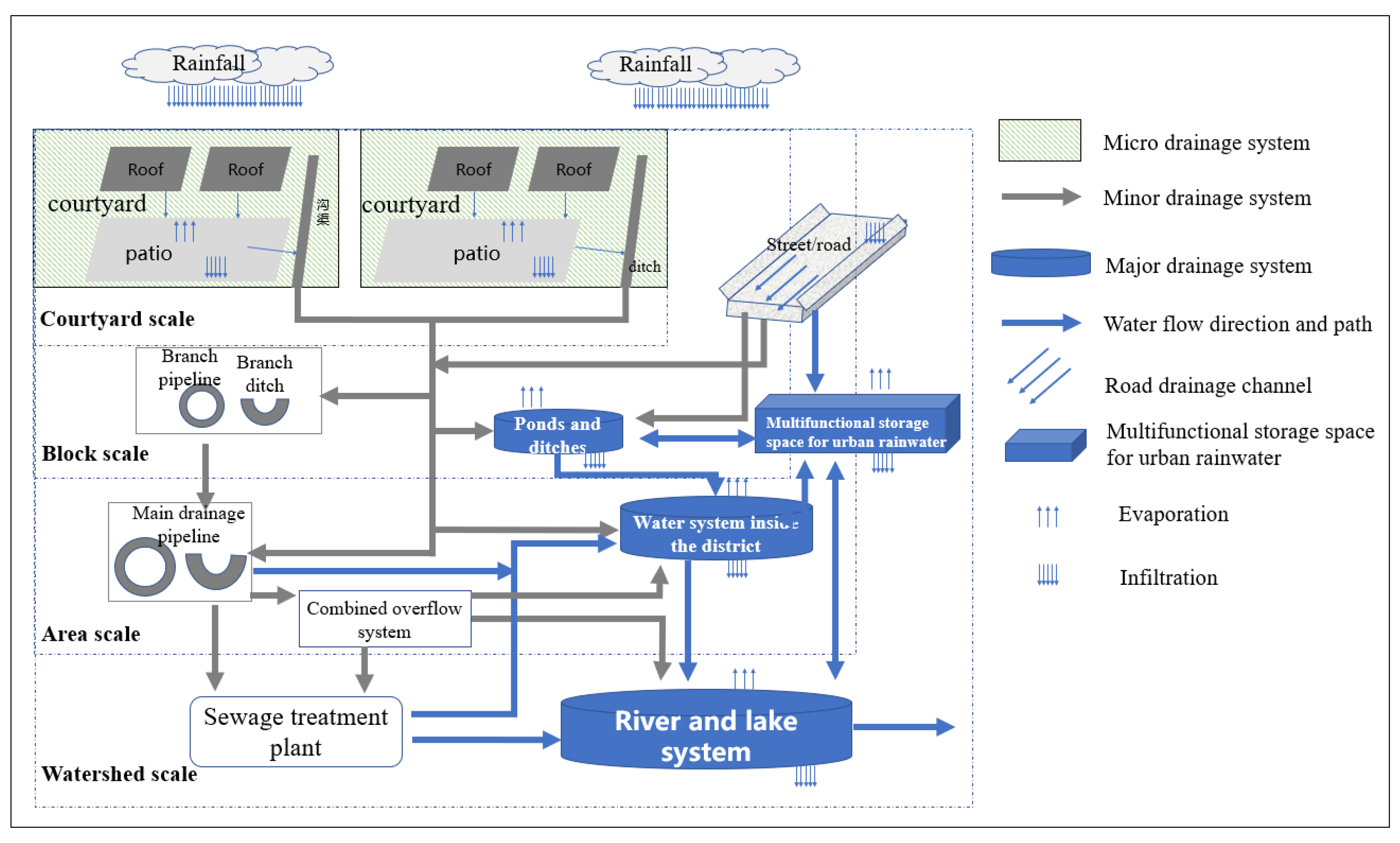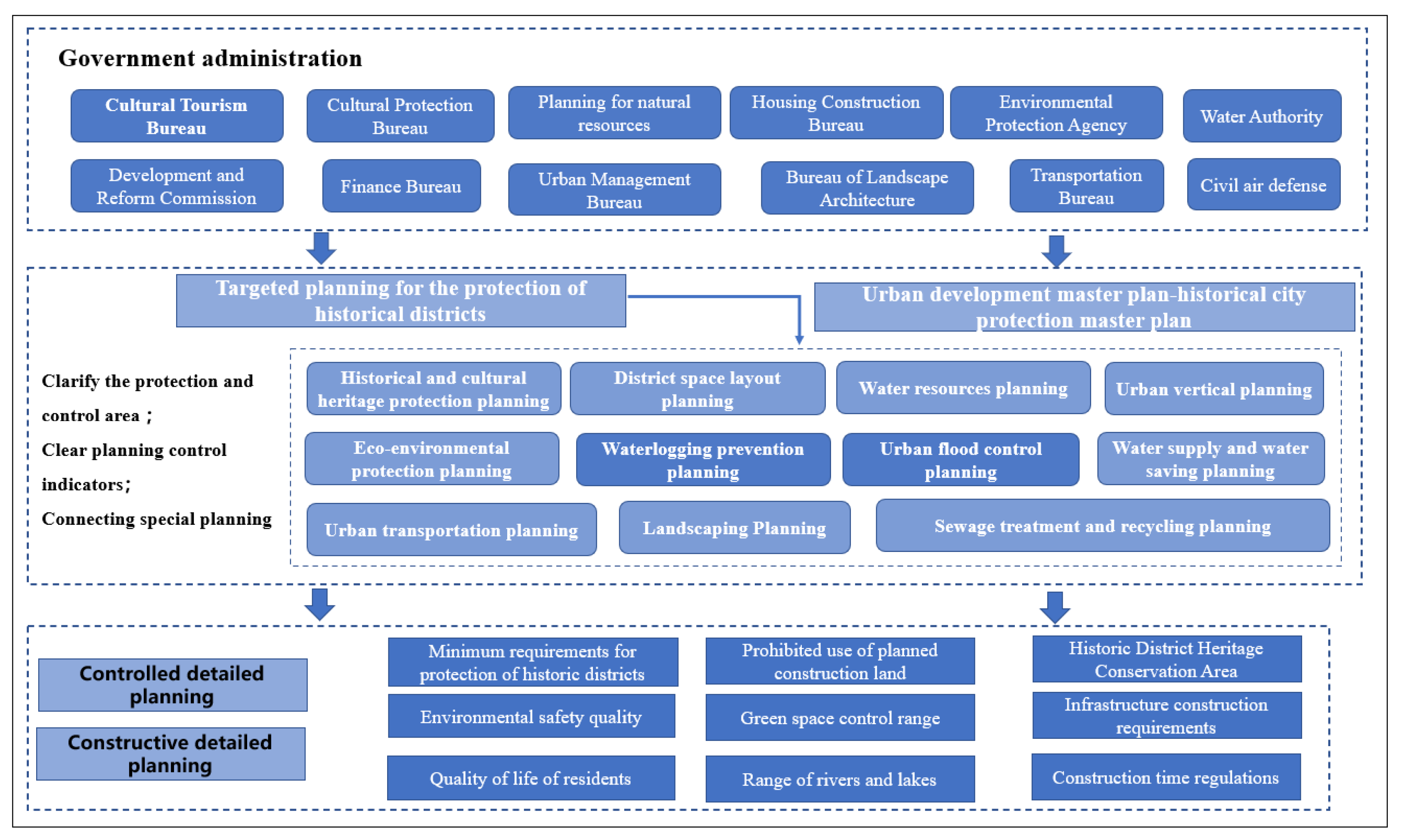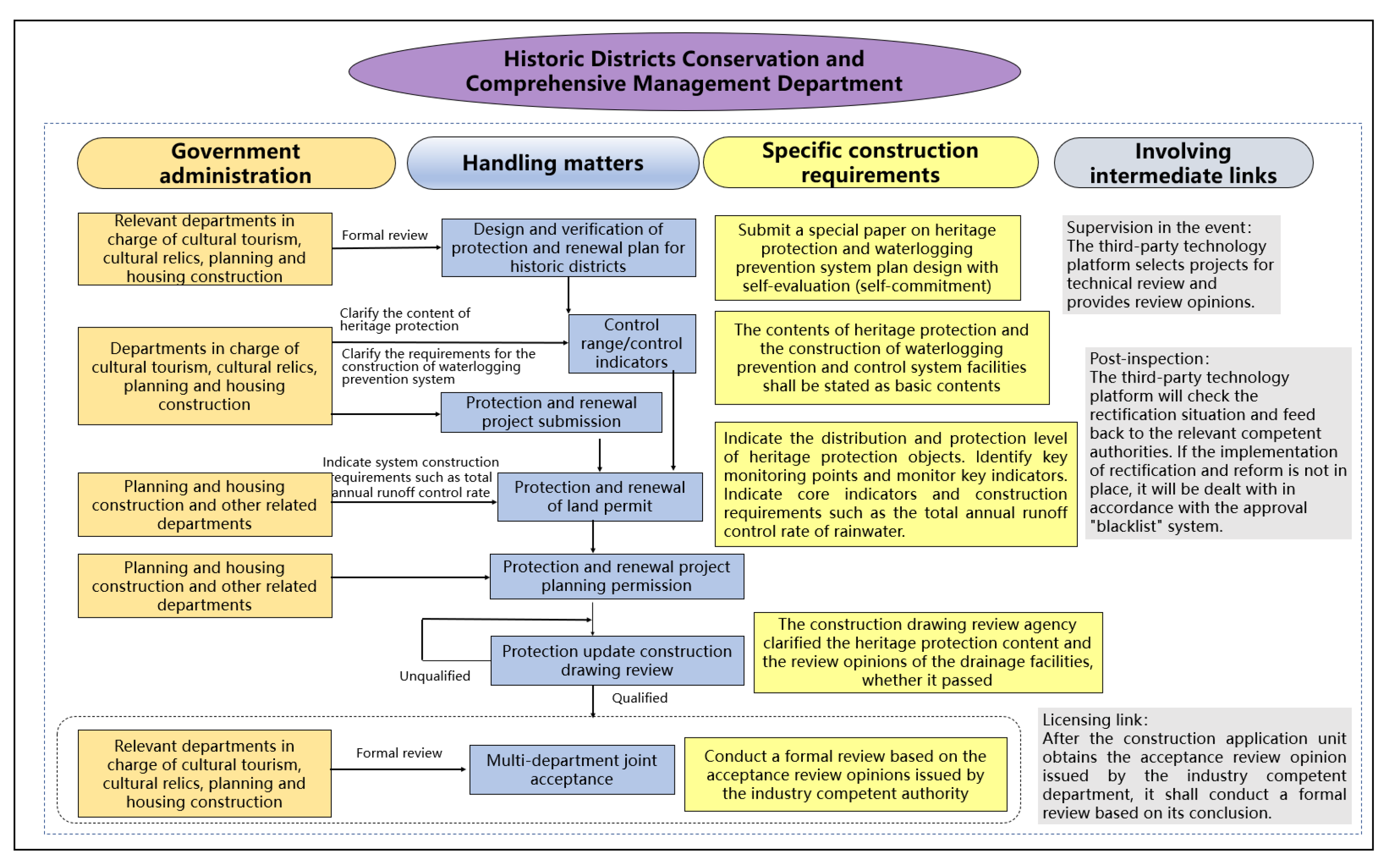Thinking Critically through Key Issues in Improving the Effectiveness of Waterlogging Prevention and Control System in China’s Historic Districts
Abstract
:1. Introduction
2. Dimension of Waterlogging Prevention and Control System
2.1. Technical Dimension of Waterlogging Prevention and Control System in Historic Districts
2.2. Management Dimension of Waterlogging Prevention and Control System in Historic Districts
3. Problems in the Improvement of the Effectiveness of the Waterlogging Prevention and Control System in Historic Districts
3.1. Lack of Pertinence in Planning and Design
3.2. The Sub-Systems of the Waterlogging Prevention and Control System Are Not Closely Coordinated
3.3. The Waterlogging Prevention and Control System Does Not Closely Cooperate with the Flood Control System
3.4. Inadequate Coordination between Government Departments and between Different Professions
4. Specific Countermeasures to Improve the Effectiveness of Waterlogging Prevention and Control Systems in Historic Districts
4.1. Relevance and Adaptability
4.2. Connection of Waterlogging Prevention and Control System and Flood Control System
4.3. Intelligent Management Platform for Waterlogging Prevention and Control in Historic Districts
4.4. Strengthen Management Coordination and Improve Governance Effectiveness
5. Conclusions
- (1)
- The improvement of the effectiveness of the waterlogging prevention and control system in historic districts should coordinate the protection of architectural heritage and the improvement of the quality of life of residents. From the perspectives of courtyards and streets in historic districts, the control of rainwater sources is carried out hierarchically, by plots, and accurately.
- (2)
- Regarding the connection between the waterlogging prevention and control system and the flood control system, consideration should be given to standards, vertical design, storage and drainage facility applications, and subsystems. At the same time, comprehensive consideration should be given to the protection of historic building heritage, landscape design, and landscaping related professional requirements to achieve the scope of towns. The drainage and waterlogging prevention and flood prevention in the river basin are coordinated and unified.
- (3)
- In order to achieve accurate monitoring and decision-making for the protection and renewal of historic districts and the prevention and control of waterlogging in cross-regional, cross-professional, and other circumstances, a joint prevention and control intelligent management platform for waterlogging prevention and control in historic districts should be built, which includes content related to architectural heritage protection and waterlogging prevention facilities. This information platform improves the speed of information transmission and the efficiency of resource allocation.
- (4)
- In order to coordinate with multiple departments to improve in the protection and renewal of historic districts and the prevention and control of waterlogging, the organization and work process should be optimized. We should establish a consultation and consultation mechanism, create a good communication platform, strengthen process control and supervision, implement process acceptance and control, and improve the comprehensive management ability of waterlogging prevention and control in historic districts.
Author Contributions
Funding
Institutional Review Board Statement
Informed Consent Statement
Data Availability Statement
Conflicts of Interest
References
- Research Group on Municipal Infrastructure Planning of Beijing Old City Historical and Cultural Protection Zone. Research on Municipal Infrastructure Planning of Beijing Old City Historical and Cultural Conservation Area; China Architecture & Building Press: Beijing, China, 2006; pp. 23–91. (In Chinese) [Google Scholar]
- Che, W.; Tang, L.; Li, H. Rain and Flood Control and Utilization in the Protection of Beijing Old City. Beijing Plan. Constr. 2012, 5, 46–52. (In Chinese) [Google Scholar]
- Liu, Y.; He, Y. Discussion about urban stormwater control in Beijing. Urban Stud. 2012, 19, 4–7. [Google Scholar]
- Li, X. Research on Adaptability Technology of Comprehensive Planning of Directly Buried Pipelines in Historic Districts. W&WE 2013, 39, 99–104. (In Chinese) [Google Scholar]
- Zhang, Y.; Li, J.; Wang, W. Analysis of Several Major Puzzles and Countermeasures of Sponge City Construction. China Water Wastewater 2016, 32, 7–11. [Google Scholar]
- Li, J.; Huang, J.; Wang, W. Problem-oriented sponge city development strategy in urban built-up area. Water Wastewater Eng. 2017, 43, 41–46. [Google Scholar]
- Han, H.; Jiang, R.; Xie, J. Research progress of the urban water-logging in China based on bibliometrics. J. Water Resour. Water Eng. 2017, 28, 134–138. [Google Scholar]
- Chen, W.; Gao, S.; Zhang, Y. Fragmentation of Urban Waterlogging Management and Its Breakthrough: Based on Holistic Governance Theory. Urban Dev. Stud. 2019, 26, 84–90. [Google Scholar]
- Che, W.; Yang, Z.; Zhao, Y.; Li, J. Analysis of urban flooding control and major and minor drainage systems in China. China Water Wastewater 2013, 29, 13–19. [Google Scholar]
- Guo, J.C.Y. Urban Flood Mitigation and Stormwater Management; CRC Press: Boca Raton, FL, USA, 2017; pp. 115–167. [Google Scholar]
- Butler, D.; Davies, J. Urban Drainage 4th; CRC Press: Boca Raton, FL, USA, 2018; pp. 237–252. [Google Scholar]
- Li, J.; Wang, Y.; Wang, W. Urban roads for major drainage system planning-design methods and cases. Water Wastewater Eng. 2017, 43, 18–24. [Google Scholar]
- Li, J.; Meng, G.; Che, W. On regulation, reservation and practical calculation in urban rainwater utilization. Water Wastewater Eng. 2007, 33, 42–46. [Google Scholar]
- Lu, J.; Li, Z.; Peng, J. Discussion on Waterlogging Control Measures in China’s Megacities. Water Wastewater Eng. 2015, 41, 93–97. (In Chinese) [Google Scholar]
- Jia, H.; Ma, H.; Sun, Z. A closed urban scenic river system using stormwater treated with LID-BMP technology in a revitalized historical district in China. Ecol. Eng. 2014, 71, 448–457. [Google Scholar] [CrossRef]
- Wang, Y. Reconstruction of Order and Meaning—Thought on Current Protection of Historical Street Blocks. Planners 2006, 9, 73–75. [Google Scholar]
- Wang, G. Historical city protection and planning management of urban purple line. Shanxi Archit. 2008, 34, 61–63. [Google Scholar]
- Hui, L.; Ding, L.; Ren, M. Sponge City Construction in China: A Survey of the Challenges and Opportunities. Water 2017, 9, 594. [Google Scholar]
- Hao, T.; Kong, Y. Dilemma and Reconstruction of Urban Drainage System. City Plan. Rev. 2019, 43, 103–107. [Google Scholar]
- Li, S. Discussion on the Calculation of Rain Runoff in Code for Design of Outdoor Wastewater Engineering. China Water Wastewater 2017, 33, 37–39. [Google Scholar]
- Lu, M.; Bi, Y.; Dong, S. Adaptability Planning Strategy of Municipal Water Supply and Drainage Pipelines for Conservation Planning of Historical and Cultural Blocks. Munic. Eng. 2018, 3, 168–171. [Google Scholar]
- Fei, Y. Technology about Rainwater Seepage Wells and Technology about Diversion of Rainwater and Sewage in Historic Block. Master’s Thesis, Yangzhou University, Yangzhou, China, 2019. [Google Scholar]
- Zhang, C.; Lü, Y.; Chen, Y. Interpretation of Technical code for urban flooding prevention and control. Water Wastewater Eng. 2017, 43, 55–59. [Google Scholar]
- He, W.; Li, C. Study of harmonious relationship about “municipal drainage, drain waterlogging, flood control” in city waterlogging. Water Wastewater Eng. 2015, 41, 85–88. [Google Scholar]
- Pan, Z. Connection of Urban Inland River Flood Control and Drainage Waterlogging Prevention Function. Urban Roads Bridges Flood Control 2019, 10, 98–101. [Google Scholar]
- Xie, Y. Development of drainage planning in view of frequent urban waterlogging disasters. City Plan. Rev. 2013, 37, 45–50. [Google Scholar]
- Leat, D.; Stoker, G. Towards Holistic Governance: The New Reform Agenda; Palgrave Macmillan: London, UK, 2002; pp. 271–273. [Google Scholar]
- Sun, S.; Yang, C.; Tian, Z. Poorly Preserved Historical District Preservation and Renovation: Changxindian Historical District, Beijing. Planners 2015, 2, 74–79. [Google Scholar]
- Chen, X. The Theoretic Construction of Contemporary Appropriate Technology Concept. New Archit. 2005, 6, 69–72. [Google Scholar]
- Deng, R. Layout Design and Technical Strategy of Municipal Water Supply and Drainage Pipeline. Build. Technol. Dev. 2018, 45, 57–58. [Google Scholar]
- Wu, W.; Guan, Y.; Chen, B. Preliminary Study on Diagnostic Techniques of Drainage System Performance in Old Towns. China Water Wastewater 2010, 26, 59–68. [Google Scholar]
- Zeng, Y. Research on Rainwater and Sewage Diversion Transformation in the Hutong Cottage Area of Beijing Old Town. China Water Wastewater 2020, 36, 56–60. [Google Scholar]
- Wang, G.; Li, H. Analysis on Waterproof and Drainage Systems of Pit House in the West of Henan Province. Appl. Mech. Mater. 2012, 238, 482–485. [Google Scholar] [CrossRef]
- Jia, H.; Zheng, W.; Zhen, X. China’s Sponge City construction: A discussion on technical approaches. Front. Environ. Sci. Eng. 2017, 11, 18. [Google Scholar] [CrossRef]
- Kang, D.; Ye, Q. Study on Evaluation and Decomposition of Volume Capture Ratio of Annual Rainfall in Sponge City. China Water Wastewater 2015, 31, 126–129. [Google Scholar]
- Huang, X.; Song, Y.; Chen, Y. Promoting the Construction of Sponge City by Developing Green Streets: Learning from the Experience of the United States. Urban Plan. Int. 2018, 33, 120–127. [Google Scholar]
- Zhang, C.; Zhang, L.; Mo, Z. Discussion on coordination of control systems between urban flooding and river basin flooding in new era. Water Wastewater Eng. 2020, 46, 9–13. [Google Scholar]
- Liu, Z.; Huang, Z.; Xu, H. Urban Flood Control and Drainage Plan Based on the Design Concept of the Vertical Elevation. Guangdong Water Resour. Hydropower 2015, 6, 36–40. [Google Scholar]
- Chen, P.; Zhang, J.; Sun, Y.Y.; Liu, X.J. Discussion on application of superposition of 1-D and 2-D coupling model for dike failure due to outside flood and water-logging model to flood control protection area. Water Resour. Hydropower Eng. 2017, 35, 89–94. [Google Scholar]
- Lin, Z. Application of Deep Tunnel Drainage System in Urban Drainage Planning. Urban Roads Bridges Flood Control 2014, 5, 143–147. [Google Scholar]
- Huang, M.; Zhang, Z.; Tan, Z. Planning, Design and Construction of Deep Underground Tunnel for Flood Control and Drainage in Urban Areas in China. Tunn. Constr. 2017, 37, 946–951. [Google Scholar]
- Zhao, X.; Zhou, Y.; Zhou, P. Discussion on Restoration of Historical Water System Based on “Urban Double Restoration” of Jingdezhen City Guidance. China Water Wastewater 2019, 35, 36–41. [Google Scholar]
- Xue, F.; Yang, R.; Ma, H. Beijing Center Area Historical Water Corridor Restoration from the Perspective of Ecological Wisdom. Chin. Landsc. Archit. 2019, 35, 61–66. [Google Scholar]
- Li, D.; Pan, J.; Chen, H. Influence of River Connecting Project on Flood Control and Drainage Analysis Based on Two-Dimensional Model. Yellow River 2016, 38, 31–33. [Google Scholar]
- Lü, Y.P.; Yang, K.; Che, Y.; Shang, Z.Y.; Zhu, H.F.; Jian, Y. Cost-effectiveness-based multi-criteria optimization for sustainable rainwater utilization: A case study in Shanghai. Urban Water J. 2013, 10, 127–143. [Google Scholar] [CrossRef]
- Chen, Z.; Lv, Y.; Yan, C.; He, X.; Zhi, X. Inspirations of International Technology and Standard Systems of Drainage Systems to China. Stand. Eng. Constr. 2014, 6, 42–47. [Google Scholar]
- U.S. Department of Transportation. Urban Drainage Design Manual, 3rd ed.; Hydraulics Engineering Publication: Washington, DC, USA, 2009. [Google Scholar]
- Yu, Y.; Gao, H.; Wang, G. “Micro Centers” Revitalized the Historic District: Study on the Renewal of the Suzhou Xuanqiaoxiang Historical District Against the Background of “Smart City”. Urban Dev. Stud. 2017, 24, 35–40. [Google Scholar]




| Year | Related Design Codes and Standards | Specific Requirements |
|---|---|---|
| 1953–1957 | Urban planning adopts the Soviet model | Mainly rely on the design and construction experience of the designer, 0.33–1 year |
| 1963 | Code for design of urban wastewater engineering (JG11-63) | Calculate the amount of rainwater with the design overflow period, and then design the rainwater pipeline according to the settlement result [20], 0.33–1 year |
| 1974 | Code for design of outdoor wastewater engineering (TJ14-74) | 0.33–2 years |
| 1987 | Code for design of outdoor wastewater engineering (TJ14-87) | 0.5–3 years |
| 2006 | Code for design of outdoor wastewater engineering (GB50014-2006) 1 | general areas: 0.5–3 years; important areas: 3–5 years |
| 2011 | Cancel the lower limit of 0.5 years; general areas: 1–3 years; Important area: 3–5 years | |
| 2014 | Small and medium cities: 2–3 years; large cities: 2–5 years | |
| 2016 | Same as the regulations in 2014, while the standard regulations should adopt the upper limit |
| Types of Courtyards in Historic Districts | The Extent of Sponge City Construction Can Be Carried Out | Specific Requirements for the Protection and Renewal |
|---|---|---|
| Key cultural relics protected courtyard | Low degree of renewability | Strictly protected, within the scope of relevant national laws and regulations |
| Historic courtyard | Low degree of renewability | According to the specifications and document requirements, evaluate the value of the courtyard heritage in detail, and carry out protection and renewal according to the construction age and current situation of the courtyard |
| General courtyard | Medium degree of renewability | According to the overall layout and style of the historic districts, take appropriate measures for reconstruction |
| Newly built courtyard | High degree of renewability | It is in harmony with the overall layout and style of the districts. The total amount of runoff control target can be set reasonably according to the courtyard conditions |
| Other types of courtyards | Take refined evaluation and improvement measures | Clarify the ownership and current conditions of the property rights of the internal units of the courtyard. Carry out courtyard protection in a refined manner according to the investigation and evaluation situation |
Publisher’s Note: MDPI stays neutral with regard to jurisdictional claims in published maps and institutional affiliations. |
© 2022 by the authors. Licensee MDPI, Basel, Switzerland. This article is an open access article distributed under the terms and conditions of the Creative Commons Attribution (CC BY) license (https://creativecommons.org/licenses/by/4.0/).
Share and Cite
Si, S.; Li, J.; Wang, Y.; Liu, L. Thinking Critically through Key Issues in Improving the Effectiveness of Waterlogging Prevention and Control System in China’s Historic Districts. Sustainability 2022, 14, 2913. https://doi.org/10.3390/su14052913
Si S, Li J, Wang Y, Liu L. Thinking Critically through Key Issues in Improving the Effectiveness of Waterlogging Prevention and Control System in China’s Historic Districts. Sustainability. 2022; 14(5):2913. https://doi.org/10.3390/su14052913
Chicago/Turabian StyleSi, Shuai, Junqi Li, Yuzhen Wang, and Lian Liu. 2022. "Thinking Critically through Key Issues in Improving the Effectiveness of Waterlogging Prevention and Control System in China’s Historic Districts" Sustainability 14, no. 5: 2913. https://doi.org/10.3390/su14052913
APA StyleSi, S., Li, J., Wang, Y., & Liu, L. (2022). Thinking Critically through Key Issues in Improving the Effectiveness of Waterlogging Prevention and Control System in China’s Historic Districts. Sustainability, 14(5), 2913. https://doi.org/10.3390/su14052913






